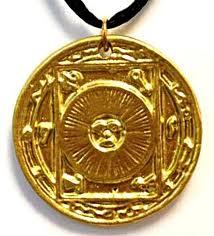An amulet, similar to a talisman, is any object intended to bring good luck or protection to its owner.
Potential amulets include gems, especially engraved gems, statues, coins, drawings, pendants, rings, plants and animals; even words said in certain occasions—for example: vade retro satana—(Latin, "go back, Satan"), to repel evil or bad luck. The word "amulet" comes from from Latin amuletum; earliest extant use in Pliny's Natural History, meaning "an object that protects a person from trouble".
Amulets and talismans vary considerably according to their time and place of origin. In many societies, religious objects serve as amulets, e.g. deriving from the ancient Celts, the clover, if it has four leaves, symbolizes good luck (not the Irish shamrock, which symbolizes the Christian Trinity).
In Bolivia and Argentina, the god Ekeko furnishes a standard amulet, to whom one should offer at least one banknote or a cigarette to obtain fortune and welfare. In certain areas of India, Nepal and Sri Lanka, it is traditionally believed that the Jackal's Horn can grant wishes and reappear to its owner at its own accord when lost. Some Sinhalese believe that the horn can grant the holder invulnerability in any lawsuit.
Some forms of Buddhism have a deep and ancient talismanic tradition. In the earliest days of Buddhism, just after the Buddha's death circa 485 BC, amulets bearing the symbols of Buddhism were common. Symbols such as conch shells, the footprints of the Buddha, and others were commonly worn. After about the 2nd century BC, Greeks began carving actual images of the Buddha. These were hungrily acquired by native Buddhists in India, and the tradition spread.
In addition to protection against supernatural powers, amulets are also used for protection against other people. For example, soldiers and those involved in other dangerous activities may use talismans to increase their luck. Carlist soldiers wore a medal of the Sacred Heart of Jesus with the inscription ¡Detente bala! ("Stop, bullet!").
In antiquity and the Middle Ages, most Jews, Christians and Muslims in the Orient believed in the protective and healing power of amulets or blessed objects. Talismans used by these peoples can be broken down into three main categories: talismans carried or worn on the body, talismans hung upon or above the bed of an infirm person, and medicinal talismans. This third category can be further divided into external and internal talismans. For example, an external amulet can be placed in a bath. The power of the amulet would be understood to be transmitted to the water, and thus to tshe bather. With internal amulets, inscriptions would be written or inscribed onto food, which was then boiled. The resulting broth, was believed to transfer the healing qualities engraved on the food into the person who consumes it.
Jews, Christians, and Muslims have also at times used their holy books in a talisman-like manner in grave situations. For example, a bed-ridden and seriously ill person would have a holy book placed under part of the bed or cushion.


